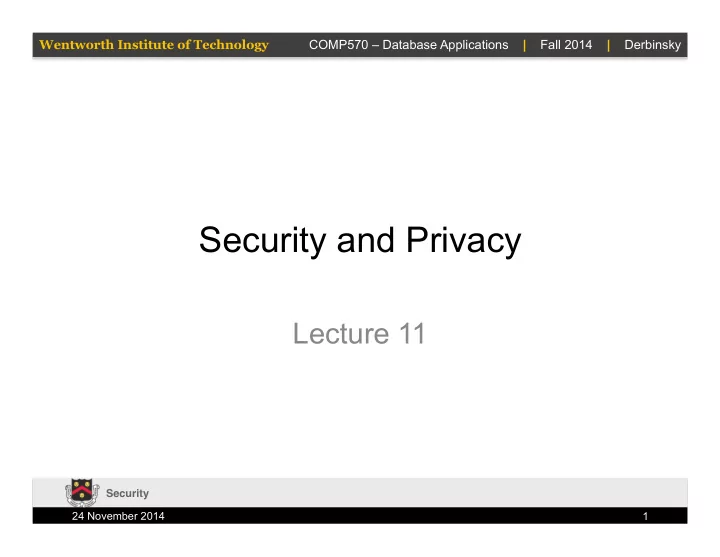

Wentworth Institute of Technology COMP570 – Database Applications | Fall 2014 | Derbinsky Security and Privacy Lecture 11 Security 24 November 2014 1
Wentworth Institute of Technology COMP570 – Database Applications | Fall 2014 | Derbinsky Outline • Context • Access Control – Discretionary, Mandatory – Least Privilege, Separate Privileges – Strong password policies, 2FA • Attacks – SQL Injection – DoS (limit password length!) – Brute force password attempts (iCloud) – Internal vs. External (80% internal via Oracle) – Separate server, updates, audit logs • Inference Control • Encryption – Symmetric, Asymmetric, Hashing – tricky to get right! – Whole Database (and backups!), Communication – Sensitive Data (salting) Security 24 November 2014 2
Wentworth Institute of Technology COMP570 – Database Applications | Fall 2014 | Derbinsky Database Design and Implementation Process Security 24 November 2014 3
Wentworth Institute of Technology COMP570 – Database Applications | Fall 2014 | Derbinsky Guidelines • Security as first-class citizen • Security via depth – Don’t assume a firewall will save you • Design for failure – What happens after a breach occurs? • Secure the weakest link – Anything but the crypto! • Obscurity is not security – Keys in binary stand out like sore thumbs – Stored procedures are not a cure for access control Security 24 November 2014 4
Wentworth Institute of Technology COMP570 – Database Applications | Fall 2014 | Derbinsky Authentication Policies • Passwords – Enforce minimum length/complexity • Also maximum (more later w.r.t. DoS) – Require updates – Goal: make guessing/cracking difficult • Cross-service • Attempts – Enforce limits to avoid brute force (iCloud) • 2 Factor Authentication (2FA) – Often infeasible – Implementation may weaken Security 24 November 2014 5
Wentworth Institute of Technology COMP570 – Database Applications | Fall 2014 | Derbinsky Discretionary Access Control • Users grant / revoke privileges to other users – Starts with root/superuser/dba – with/without ¡GRANT ¡OPTION ¡ • Privileges typically apply at multiple levels – Global, database, table, column • Access matrix model – Users x Objects • Fairly universal Security 24 November 2014 6
Wentworth Institute of Technology COMP570 – Database Applications | Fall 2014 | Derbinsky MySQL (user) Security 24 November 2014 7
Wentworth Institute of Technology COMP570 – Database Applications | Fall 2014 | Derbinsky MySQL (db) Security 24 November 2014 8
Wentworth Institute of Technology COMP570 – Database Applications | Fall 2014 | Derbinsky MySQL (tables_priv) Security 24 November 2014 9
Wentworth Institute of Technology COMP570 – Database Applications | Fall 2014 | Derbinsky MySQL (columns_priv) Security 24 November 2014 10
Wentworth Institute of Technology COMP570 – Database Applications | Fall 2014 | Derbinsky Mandatory Access Control • Objects are classified with security levels • Users are afforded security clearance • Government model, not typically supported Security 24 November 2014 11
Wentworth Institute of Technology COMP570 – Database Applications | Fall 2014 | Derbinsky Privilege Policies • Principle of least privilege • Privilege separation • Abuse – Unauthorized • Mitigate escalation attacks – Authorized • Teachers changing grades • Firing a DBA Security 24 November 2014 12
Wentworth Institute of Technology COMP570 – Database Applications | Fall 2014 | Derbinsky SQL Injection SQL manipulation for nefarious purpose Method • String manipulation – Parameters, function calls • Code injection (e.g. buffer overflow) Goals • Fingerprinting • DoS • Bypass authentication/privilege escalation • Remote execution Protection • Parameterized statements • Filter input • Limit use of custom functions Security 24 November 2014 13
Wentworth Institute of Technology COMP570 – Database Applications | Fall 2014 | Derbinsky Denial of Service (DoS) Any exposed interface: – Failed login • Lock out users • Resource utilization via long password verification – Complex queries Mitigation – Resource limits – Patching – Monitoring Security 24 November 2014 14
Wentworth Institute of Technology COMP570 – Database Applications | Fall 2014 | Derbinsky Issues • Protect against internal attacks – Oracle: up to 80% of data loss • Isolate DBMS – Separate machine, VM • Regular patching policies • Audit logs Security 24 November 2014 15
Wentworth Institute of Technology COMP570 – Database Applications | Fall 2014 | Derbinsky Inferential Security • Some services offer parameterized aggregate data – But must protect sensitive individual data! • Prior knowledge and/or clever exploration might yield queries that reveal private information – Find “average” salary of <insert conditions that identify single individual> • Techniques – Minimum result set size threshold – Added noise – Group partitioning Security 24 November 2014 16
Wentworth Institute of Technology COMP570 – Database Applications | Fall 2014 | Derbinsky Encryption • Symmetric – Single key encrypts/decrypts • Asymmetric – 2 Keys: public encryption, private decryption • Hashing – No decryption • Encryption theory is solid, implementation is tricky – High-quality randomness – Bug-free code Security 24 November 2014 17
Wentworth Institute of Technology COMP570 – Database Applications | Fall 2014 | Derbinsky Basics • Encrypt database files – Including backups! – Native or 3 rd -party wrapper – Can be difficult to implement while being resilient to restarts • Encrypt application communication Security 24 November 2014 18
Wentworth Institute of Technology COMP570 – Database Applications | Fall 2014 | Derbinsky Sensitive Data • When dealing with sensitive data, always consider how it needs to be used • If only verification (e.g. password), hash • If usage, encrypt – Ideally segment usage (e.g. CC entry vs. processing = public/private + last 4 as string) Security 24 November 2014 19
Wentworth Institute of Technology COMP570 – Database Applications | Fall 2014 | Derbinsky Password Salting • Salt = additional input prepended to hashed value – Ideally 1 hash/sensitive value – Stored text = salt + hash(salt . sensitive value) • Increases complexity of usefully processing bulk data – Re-use within service, across services – Rainbow tables Security 24 November 2014 20
Recommend
More recommend